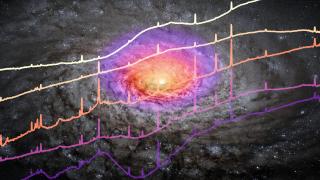Bibcode
Riffel, R. A.; Storchi-Bergmann, T.; Riffel, R.; Bianchin, M.; Zakamska, N. L.; Ruschel-Dutra, D.; Bentz, M. C.; Burtscher, L.; Crenshaw, D. M.; Dahmer-Hahn, L. G.; Dametto, N. Z.; Davies, R. I.; Diniz, M. R.; Fischer, T. C.; Harrison, C. M.; Mainieri, V.; Revalski, M.; Rodriguez-Ardila, A.; Rosario, D. J.; Schönell, A. J.
Bibliographical reference
Monthly Notices of the Royal Astronomical Society
Advertised on:
5
2023
Citations
42
Refereed citations
35
Description
We present the hot molecular and warm ionized gas kinematics for 33 nearby (0.001 ≲ z ≲ 0.056) X-ray selected active galaxies using the H$_2\, 2.1218\, \mu$m and Br γ emission lines observed in the K band with the Gemini near-infrared integral field spectrograph. The observations cover the inner 0.04-2 kpc of each active galactic nucleus at spatial resolutions of 4-250 pc with a velocity resolution of σinst ≈ 20 ${\rm km\, s^{-1}}$. We find that 31 objects (94 per cent) present a kinematically disturbed region (KDR) seen in ionized gas, while such regions are observed in hot molecular gas for 25 galaxies (76 per cent). We interpret the KDR as being due to outflows with masses of 102-107 and 100-104 M⊙ for the ionized and hot molecular gas, respectively. The ranges of mass-outflow rates ($\dot{M}_{\rm out}$) and kinetic power ($\dot{E}_{\rm K}$) of the outflows are 10-3-101 M⊙ yr-1 and ~1037-1043 erg s-1 for the ionized gas outflows, and 10-5-10-2 M⊙ yr-1 and 1035-1039 erg s-1 for the hot molecular gas outflows. The median coupling efficiency in our sample is $\dot{E}_{\mathrm{K}}/L_{\rm bol}\approx 1.8\times 10^{-3}$ and the estimated momentum fluxes of the outflows suggest they are produced by radiation-pressure in low-density environment, with possible contribution from shocks.
Related projects

Nuclear Activity in Galaxies: a 3D Perspective from the Nucleus to the Outskirts
This project consists of two main research lines. First, the study of quasar-driven outflows in luminous and nearby obscured active galactic nuclei (AGN) and the impact that they have on their massive host galaxies (AGN feedback). To do so, we have been granted time with the Gran Telescopio CANARIAS (GTC) in the optical and near-infrared ranges
Cristina
Ramos Almeida